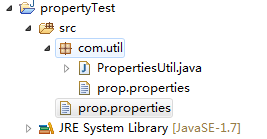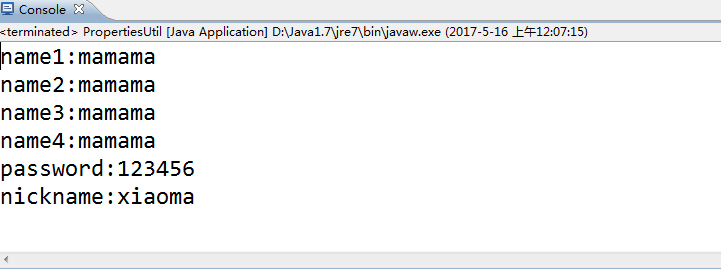java加载properties文件的方式主要分为两大类:一种是通过import java.util.Properties类中的load(InputStream in)方法加载;
另一种是通过import java.util.ResourceBundle类的getBundle(String baseName)方法加载。
注意:一定要区分路径格式
实现代码如下:
package com.util;
import java.io.FileInputStream;
import java.io.FileNotFoundException;
import java.io.IOException;
import java.io.InputStream;
import java.util.Properties;
import java.util.PropertyResourceBundle;
import java.util.ResourceBundle;
public class PropertiesUtil {
private static String basePath = "src/prop.properties";
private static String name = "";
private static String nickname = "";
private static String password = "";
/**
* 一、 使用java.util.Properties类的load(InputStream in)方法加载properties文件
*
*/
public static String getName1() {
try {
Properties prop = new Properties();
InputStream is = new FileInputStream(basePath);
prop.load(is);
name = prop.getProperty("username");
} catch (FileNotFoundException e) {
e.printStackTrace();
} catch (IOException e) {
e.printStackTrace();
}
return name;
}
/**
* 二、 使用class变量的getResourceAsStream()方法
* 注意:getResourceAsStream()读取路径是与本类的同一包下
*
*/
public static String getName2() {
Properties prop = new Properties();
InputStream is = PropertiesUtil.class
.getResourceAsStream("/com/util/prop.properties");
try {
prop.load(is);
name = prop.getProperty("username");
} catch (IOException e) {
e.printStackTrace();
}
return name;
}
/**
* 三、
* 使用class.getClassLoader()所得到的java.lang.ClassLoader的getResourceAsStream()方法
* getResourceAsStream(name)方法的参数必须是包路径+文件名+.后缀 否则会报空指针异常
*
*/
public static String getName3() {
Properties prop = new Properties();
InputStream is = PropertiesUtil.class.getClassLoader()
.getResourceAsStream("com/util/prop.properties");
try {
prop.load(is);
} catch (IOException e) {
e.printStackTrace();
}
return name;
}
/**
* 四、 使用java.lang.ClassLoader类的getSystemResourceAsStream()静态方法
* getSystemResourceAsStream()方法的参数格式也是有固定要求的
*
*/
public static String getName4() {
Properties prop = new Properties();
InputStream is = ClassLoader
.getSystemResourceAsStream("com/util/prop.properties");
try {
prop.load(is);
name = prop.getProperty("username");
} catch (IOException e) {
e.printStackTrace();
}
return name;
}
/**
* 五、 使用java.util.ResourceBundle类的getBundle()方法
* 注意:这个getBundle()方法的参数只能写成包路径+properties文件名,否则将抛异常
*
*/
public static String getName5() {
ResourceBundle rb = ResourceBundle.getBundle("com/util/prop");
password = rb.getString("password");
return password;
}
/**
* 六、 使用java.util.PropertyResourceBundle类的构造函数
*
*/
public static String getName6() {
try {
InputStream is = new FileInputStream(basePath);
ResourceBundle rb = new PropertyResourceBundle(is);
nickname = rb.getString("nickname");
} catch (FileNotFoundException e) {
e.printStackTrace();
} catch (IOException e) {
e.printStackTrace();
}
return nickname;
}
/**
* 测试
*
*/
public static void main(String[] args) {
System.out.println("name1:" + PropertiesUtil.getName1());
System.out.println("name2:" + PropertiesUtil.getName2());
System.out.println("name3:" + PropertiesUtil.getName3());
System.out.println("name4:" + PropertiesUtil.getName4());
System.out.println("password:" + PropertiesUtil.getName5());
System.out.println("nickname:" + PropertiesUtil.getName6());
}
}
文件路径:

prop.properties文件:
username=mamama
nickname=xiaoma
password=123456
输出结果:
